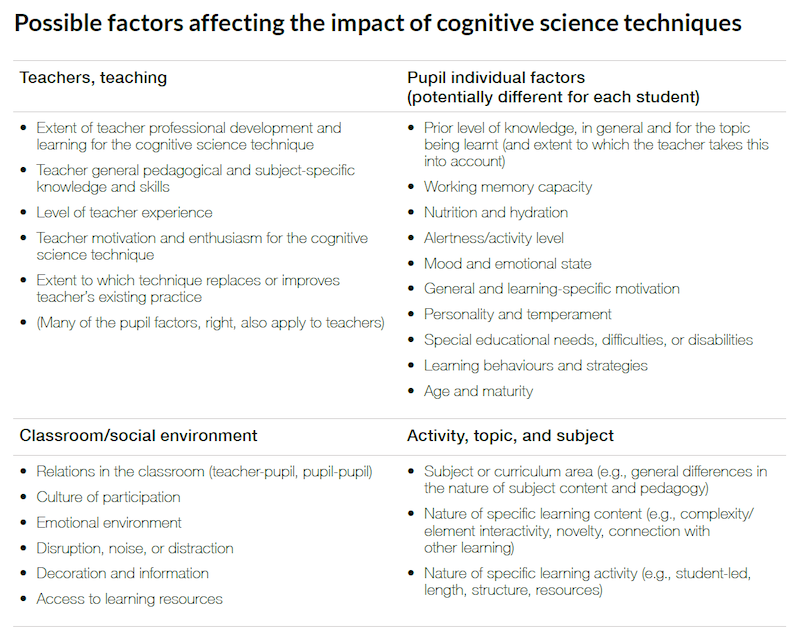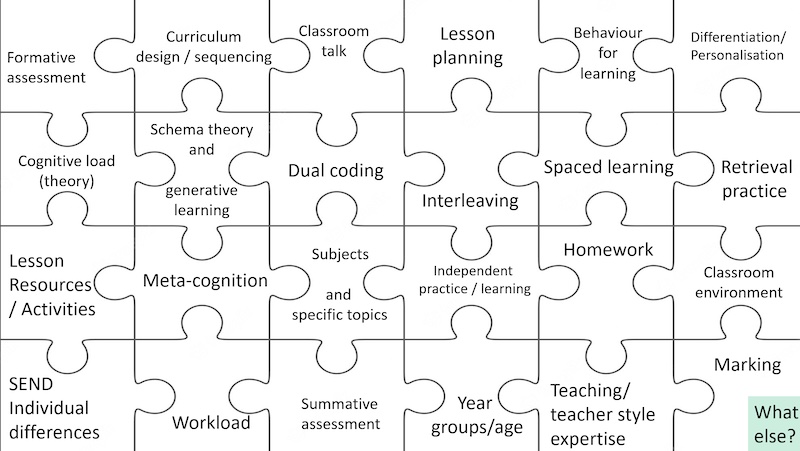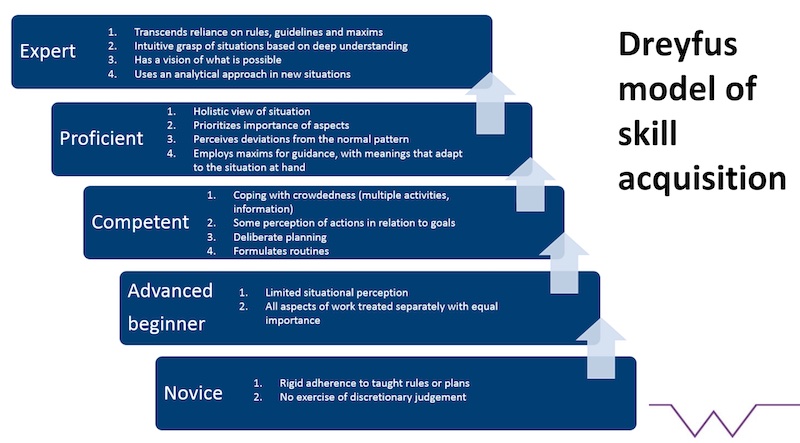Research into practice: From blueprint to jigsaw
Back
This piece was initially published on Sarah's Overpractised blog here.
This blog reflects on the recent work and thinking of Dr Tom Perry, author of the Education Endowment Foundation’s (EEF’s) Cognitive Science in the Classroom (Perry et al., 2021).
The EEF review explored what happens when cognitive science is applied in realistic classroom conditions. While concluding that cognitive science shows great promise and recommending that teachers have working knowledge of it, it is fair to say that it also raised a few critical questions.
I’ve spoken with Tom to discuss some of the questions thrown up by the review.
And it seems we have a problem…
On the one hand, cognitive science research in the laboratory and controlled classroom conditions seems to turn out positive, replicable results supporting the use of techniques like retrieval, spacing, interleaving, dual coding, elaboration etc.
But on the other hand, when studies test cognitive science in realistic classroom environments, the effects are mixed and the effect sizes tend to be much smaller (Perry et al., 2021). Worse, the few examples of cognitive science being trialled at scale in realistic conditions produced disappointing results (Cromley et al., 2016; Davenport et al., 2020; Schunn et al., 2018; Yang et al., 2020).
To sum it up: when we try to operationalise cognitive science in the classroom, something gets lost in translation.
A lot of the discussion has understandably focused on how to do techniques like retrieval practice really well. This includes thinking about what ‘good’ looks like in different subjects and phases and how to avoid the techniques ‘lethally mutating’ into things that don’t work. Then there is the importance of thinking about what happens when techniques ‘collide’ with other aspects of classroom teaching and learning. Here’s some factors present in the classroom which can affect the results of cognitive science studies* (EEF, 2021, p.13):

EEF (2021) Possible factors affecting the impact of cognitive science techniques
These factors might be causing our translation problem: the classroom is complex and all these factors (and more) could vary the impact cognitive science approaches have on learning. Therefore, we must be careful about how we view and use cognitive science research…
Tom urges us to move from blueprint to jigsaw thinking. What does he mean?
Viewed as a blueprint, we assume cognitive science research provides us with a set of instructions for how to implement these practices in the ‘average’ classroom. But the truth is, cognitive science is only providing us with principles to aid smarter decisions in our actual classes.
By principles we mean things like –
- Retrieval practice is better than rereading/restudy for improving recall and retention.
- Spacing practice to allow for forgetting can more efficiently lead to long-term learning.
The cognitive science research is not providing us with a blueprint of practices and how to implement them. And how could it? With all the factors in the table above to consider, only teachers could have the expertise to translate principles into effective practices.
Instead of a blueprint, Tom urges us to see cognitive science as part of a jigsaw like the one below (cognitive science approaches on the second line).

Why a jigsaw? Because the jigsaw respects the fact that cognitive science approaches are pieces of a much wider puzzle of teaching and learning. Yes, we want them in there, but we need to consider how they interact with other parts of the puzzle.
Here’s some examples of how we can consider cognitive science alongside other areas of teaching:
- I consider behaviour for learning and the age group I teach alongside cognitive load theory. I recognise that the instructions I give need to be truncated and chunked to avoid overloading my students.
- My students struggle to monitor their work during independent practice. I read up about supporting metacognition. I decide to model tackling independent practice tasks exposing my thought process as I monitor and adjust the route I take.
The point is, using cognitive science effectively means building it into existing good practice (Churches et al., 2020). This casts doubt on blanket approaches to implementing these techniques in schools. If all teachers are expected to apply say, retrieval practice or metacognitive strategies in the same way, at the same point in the lesson, then a lot of this puzzle (and therefore of teaching and learning) is ignored.
It’s not that there aren’t ‘stock’ techniques to learn and habits and routines to establish. It’s that these will only get us so far. To get from good to great – there is no escaping the need to piece together a bigger jigsaw.
So, what do we do?
We accept that cognitive science approaches are pieces of a complex puzzle. We strive to develop teachers’ expertise in all pieces of the puzzle so they can make better decisions about how to use cognitive science to improve their teaching like in the examples above.
How do we characterise teacher expertise and develop it? Tom suggests we use a model of how expertise develops: Dreyfus’ Five-Stage Model of Adult Skill Acquisition (Dreyfus, 2004).

Let’s have a look at these 5 stages:
Novice: a teacher relatively novice in cognitive science is starting to engage with the research. They aren’t sure how to start applying it, and they need rules to get them started. They are encouraged to adopt the rule ‘plan for students to answer 5 quick retrieval practice questions at the start of every lesson’ to dip their toe in the water.
Advanced beginner: this teacher is developing their awareness of how cognitive science fits with some other puzzle pieces, but they can’t balance priorities. For example, they notice that some students are leaving lots of answers blank during retrieval practice quizzes. Ordinarily they might provide some scaffolding, but they know they are supposed to be getting students to retrieve from memory, so they stick to what they’re doing.
Competent: the competent teacher can pay attention to the mass of information they’re getting and devise actions related to goals. They are also continuing to develop their understanding of the research. For example, they are aware when some students are struggling to retrieve and try methods such as using cues and hints rather than just giving students the answer or leaving them to fail.
Proficient: the proficient teacher sees the principles and maxims that allow them to stay true to the cognitive science whilst deviating to consider other pieces of the puzzle. For example, they note that 5 quick retrieval questions isn’t that useful throughout the curriculum. As students learn the basics, they need to do longer retrieval tasks sometimes mid-way through lessons. They also note that quizzing isn’t the only way students can retrieve: this can happen throughout the lesson through apt use of formative assessment strategies.
Expert: the expert teacher intuitively uses cognitive science principles in concert with the relevant puzzle pieces. They know which bit of the jigsaw needs attention at any point. i.e., they have a holistic picture of what all of the jigsaw should look like, how they interact and are able to notice and act to address the priority factors that are limiting learning. For example, they intuitively recognise where two ideas in a topic are likely to confuse students and present them side by side to begin with and then factor in interleaved practice later in the lesson to check students can discriminate between the two.
Drawing all threads together, we can see that utilising cognitive science effectively in the classroom means developing teachers’ expertise in three areas:
- All aspects of teaching practice,
- Cognitive science research and
- Making decisions about how cognitive science affects the rest of the jigsaw of teaching.
Tom reminds us that this can be catalysed by effective professional development.**
To sum up…
- Cognitive science gives us principles not “off the shelf” practices.
- Cognitive science approaches must be interpreted in relation to other aspects of teaching and learning: think jigsaw not blueprint.
- Developing teacher expertise in cognitive science can be seen through the lens of the Dreyfus model. This gives us a helpful way to see that teachers’ needs vary according to their level of classroom experience and familiarity with cognitive science.
- Teachers may benefit from professional development that helps them move from reliance on rigid rules to the flexible use of principles to the intuitive synthesis of cognitive science with other aspects of teaching.
With huge thanks to Dr Tom Perry (@TWPerry1) for collaborating on this blog to share his work!
* These are typically averaged/controlled out in most research studies.
** Tom suggests turning to relevant research including the Teacher Development Trust’s “Developing great teaching” (Cordingley et al., 2014) and the EEF’s “Effective Professional Development Guidance Report” (EEF, 2021).
Sarah Cottingham is Associate Dean at the Ambition Institute and works on training teacher educators; she is also a former English teacher.
References
Churches, R., Dommett, E. J., Devonshire, I. M., Hall, R., Higgins, S., & Korin, A. (2020). Translating laboratory evidence into classroom practice with teacherâ€Âled randomized controlled trials—A perspective and metaâ€Âanalysis. Mind, Brain, and Education, 14(3), 292-302.
Cordingley, P., Higgins, S., Greany, T., Buckler, N., Coles-Jordan, D., Crisp, B., … & Coe, R. (2015). Developing great teaching: lessons from the international reviews into effective professional development. https://tdtrust.org/wp-content/uploads/2015/10/DGT-Full-report.pdf
Cromley, J. G., Weisberg, S. M., Dai, T., Newcombe, N. S., Schunn, C. D., Massey, C., & Merlino, F. J. (2016). Improving middle school science learning using diagrammatic reasoning. Science Education, 100(6), 1184- 1213.
Davenport, J. L., Kao, Y. S., Matlen, B. J., & Schneider, S. A. (2020). Cognition research in practice: engineering and evaluating a middle school math curriculum. The Journal of Experimental Education, 88(4), 516-535.
Education Endowment Foundation (2021). Effective Professional Development: Guidance Report. https://d2tic4wvo1iusb.cloudfront.net/eef-guidance-reports/effective-professional-development/EEF-Effective-Professional-Development-Guidance-Report.pdf?v=1670402326
Dreyfus, S. E. (2004). The five-stage model of adult skill acquisition. Bulletin of science, technology & society, 24(3), 177-181.
Perry, T., Lea, R., Jørgensen, C. R., Cordingley, P., Shapiro, K., & Youdell, D. (2021). Cognitive science in the classroom. London: Education Endowment Foundation.
Schunn, C. D., Newcombe, N. S., Alfieri, L., Cromley, J. G., Massey, C., & Merlino, J. F. (2018). Using principles of cognitive science to improve science learning in middle school: What works when and for whom?. Applied cognitive psychology, 32(2), 225-240.
Yang, R., Porter, A. C., Massey, C. M., Merlino, J. F., & Desimone, L. M. (2020). Curriculumâ€Âbased teacher professional development in middle school science: A comparison of training focused on cognitive science principles versus content knowledge. Journal of Research in Science Teaching, 57(4), 536- 566.

